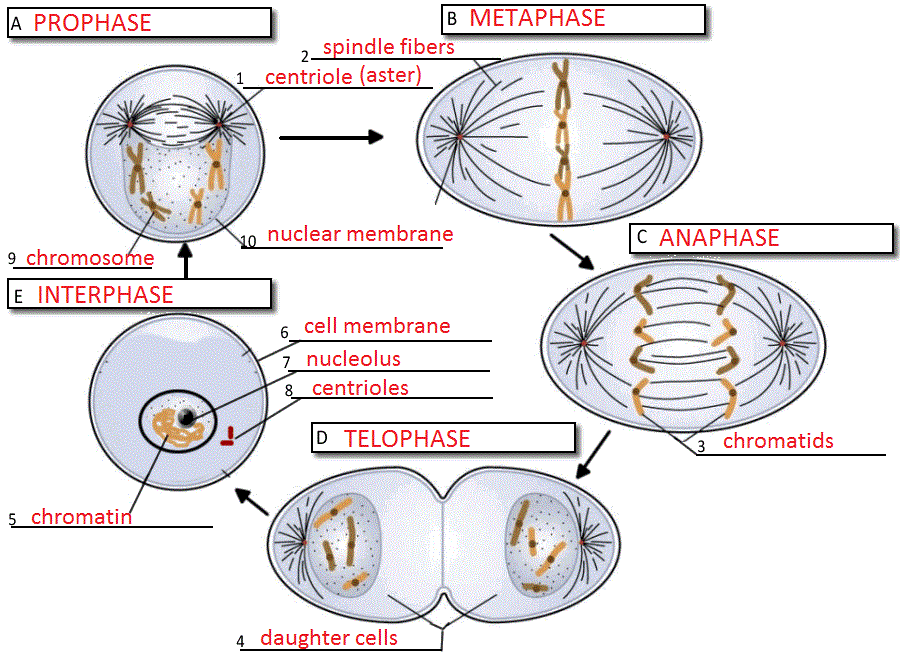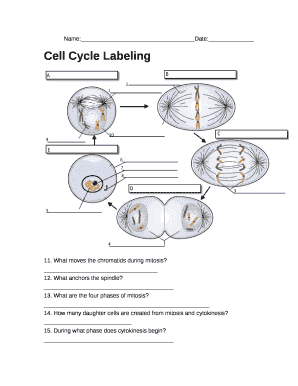Imagine a bustling city, teeming with life. Buildings rise, roads expand, and the population grows. But what if there were no rules, no regulations to guide this growth? Chaos would ensue. The city would sprawl uncontrollably, neglecting its infrastructure and eventually collapsing under its own weight. Now imagine your body as that bustling city. Billions of cells, each with its own essential role, must coordinate their growth and division to maintain a healthy, functional organism. Thankfully, there’s a rigorous system in place: the cell cycle, a finely tuned symphony of proteins and signals that orchestrate the life and death of every cell. But just like a city, the cell cycle needs regulation, ensuring that growth and division happen at the right time, in the right place, and in the right amount.

Image: www.biologycorner.com
This precise regulation is crucial for life as we know it. Every moment, cells in your body are dying and being replaced, a silent and intricate dance that ensures your tissues and organs remain healthy and functional. Imagine a cut on your finger. Without proper cell cycle regulation, the wound might never heal, or worse, become cancerous. This article dives into the fascinating world of the cell cycle, uncovering the molecular machinery that governs our existence and revealing how scientists are working to unravel its mysteries for the benefit of humankind.
The Cell Cycle: An Elegant Ballet of Molecular Partners
The cell cycle is not a random, chaotic event. It’s a meticulously defined process, divided into four distinct phases:
- G1 Phase: Imagine a cell finishing its work, like a worker completing a construction project. It’s resting, preparing for the next task, gathering resources like materials for the building project. During this G1 phase, the cell synthesizes vital proteins and organelles, growing in size and ensuring it’s ready for the next stage.
- S Phase: It’s time to start building! The cell enters the S phase, meticulously replicating its entire DNA, ensuring each daughter cell receives a complete blueprint for life. This is like photocopying the architectural plans of the city before the construction starts. It’s a critical step, as even a slight error can lead to genetic instability and potential disease.
- G2 Phase: This is the critical checkpoint before the big event. Like a final inspection before a grand opening, the cell checks for any errors in DNA replication and ensures all proteins needed for cell division are present and ready.
- M Phase: The countdown begins! This phase marks the spectacular display of mitosis, the division of the cell’s nucleus. It’s like the grand opening of the city, where chromosomes, carrying the cell’s genetic material, condense and align in the center of the cell, ready to be split equally into two new daughter cells. Mitosis, like a delicate dance, ensures each daughter cell inherits an identical copy of the genetic material.
But this elegant ballet is not free from potential errors. Sometimes, cells fail to properly regulate their cycle, leading to uncontrolled growth and division, a hallmark of cancer. This is where our understanding of cell cycle regulation becomes crucial, not just for understanding disease but also for devising therapies.
The Guardians of the Cell Cycle: Cyclins and CDKs
Imagine a city’s traffic police. They direct the flow of vehicles, ensuring smooth and safe movement. In the cell cycle, these “traffic police” are the proteins known as cyclins and cyclin-dependent kinases (CDKs). These molecular partners work in tandem to regulate the timing and order of each phase.
- Cyclins: These proteins act like the “traffic lights” of the cell cycle, signaling the transition from one phase to the next. Each cyclin has a specific role, like regulating the G1-S transition or the G2-M transition. They fluctuate in concentration throughout the cell cycle, ensuring each step takes place at the right time.
- CDKs: These are the “police officers” that enforce the rules. They are like enzymes, but they need cyclins to be activated. Once bound to their specific cyclin partner, they become potent drivers of cell cycle progression. Imagine a traffic police officer who needs to be paired with a traffic light to direct traffic effectively. CDKs phosphorylate, or add a phosphate group to, specific target proteins, like a signal that activates or deactivates the protein’s function, akin to a command to accelerate or stop traffic.
This elegant interplay of cyclins and CDKs orchestrates the entire cell cycle, ensuring the cell progresses smoothly through each stage.
However, disruptions in this delicate balance can have profound consequences.
Unraveling the Secrets of Cancer: Disrupted Cell Cycle Control
Cancer is a complex disease, often characterized by uncontrolled cell proliferation. Within the cancerous cell, the rules of the game change. This uncontrolled growth, fueled by deregulated cell cycle control, can lead to tumor formation and potentially spread to other parts of the body.
Imagine the cityscape again, with uncontrolled construction projects popping up everywhere, ignoring traffic laws, destabilizing the entire city. Imagine buildings being built on top of each other, roads collapsing under the weight of unchecked development, and the entire city falling apart. In a similar way, malfunctions in the cell cycle, like faulty traffic signals, contribute to the chaos of cancer.
But understanding the intricate mechanisms of cell cycle regulation gives us a powerful tool to combat cancer. We can target specific defects that fuel its uncontrolled growth.

Image: www.pdffiller.com
Therapeutic Strategies: Targeting the Cell Cycle
Imagine a city’s traffic control system. If this system is disrupted, causing gridlock and chaos, engineers can build bypasses, reroute traffic, and install new systems to improve the flow of vehicles.
Similarly, scientists are developing therapeutic strategies that aim to restore order to the cell cycle of cancer cells. These strategies may involve:
- CDK Inhibitors: Like cutting off the power to faulty traffic lights, these drugs target specific CDKs, inhibiting their activity and halting the cell cycle, preventing uncontrolled proliferation.
- Checkpoint Inhibitors: These proteins, like new traffic regulations, help cells recognize and correct errors in DNA replication, slowing down or even stopping the cell cycle before it’s too late.
By understanding the intricacies of cell cycle regulation and its implications in disease, scientists are developing new and innovative therapies that may one day restore order to the bustling city within each of us.
The Future of Cell Cycle Research: Unfinished Symphony
The cell cycle is a dynamic and complex process, and we are still discovering its intricate mechanisms and their potential for impacting health and disease. Just like a city that constantly evolves, the cell cycle also continues to unfold new mysteries.
Imagine a city’s growth, not just expanding horizontally, but also vertically, creating new layers of complexity and interconnectivity. Similarly, researchers are working to unravel the connections between the cell cycle and other cellular pathways, understanding how it interacts with metabolism, aging, and immunity.
Beyond Cancer: Cell Cycle Regulation in Health and Disease
The cell cycle plays an essential role in many biological processes beyond cancer. From the development of embryos to the repair of wounds, the orchestrated dance of cyclins and CDKs governs our health and well-being. This understanding opens doors for exciting new applications, such as:
- Regenerative Medicine: Harnessing the power of cell cycle regulation holds immense potential for treating conditions like Parkinson’s disease or spinal cord injuries, where the generation of new cells and tissues is paramount.
- Developmental Biology: Delving into the complexities of cell cycle control during embryonic development can offer crucial insights into birth defects and congenital diseases.
- Aging Research: Understanding how the cell cycle changes with age can pave the way for interventions that address the decline of tissue renewal and function.
Regulating The Cell Cycle Answer Key
Call to Action: Enhancing Awareness and Engagement
The cell cycle is a fascinating world, full of intricate mechanisms and profound implications for our health and well-being. By understanding its role in maintaining life and combating disease, we can make informed decisions about our health and actively participate in the journey towards a future filled with scientific advancements.
Explore further resources, share your thoughts and experiences with cell cycle regulation, and join the growing community of individuals embracing the power of scientific knowledge to create a healthier and brighter future.






